9 thoughts about 2024 BMW i4 eDrive35

Three years ago, when we reviewed the then-new BMW i4 EV, Road Test Editor Zac Palmer headlined it, “Pleasingly normal, delightfully fast.” He was reviewing the two models on the market at that time, the 335-horsepower i4 eDrive40 and the 536-horsepower M50. The latter also got a “ridiculously quick” superlative; though it makes futuristic Hans Zimmer noises rather than a snarl or roar, that M50 is a monster.
But how often in daily life do you need to conjure a monster? Do you need monstrosity or moderation? Far tamer is the BMW i4 eDrive35, the single-motor, rear-wheel-drive version that makes 282 horsepower and 295 pound-feet of torque. It also comes with a smaller battery pack, 68.7 kilowatt-hour versus 84.3 in the others, and it has a range rating of 276 miles. Also relatively moderate is the price, starting at $53,195 for 2024 including destination. (We don’t know the price of the 2025 i4 eDrive35 yet, but we do know BMW’s reasonable $995 destination fee gets an increase.)
Here are a few impressions after a week in the i4’s least-powerful variant.
It’s plenty fast enough
So, is 282 hp sufficient? It is. The eDrive35 is a rocket, it just isn’t hypersonic like that M50. Its stated 0-to-60 mph time is 5.8 seconds, a solid number for a luxury sedan, but even that seems conservative once you’ve driven it, knowing that the Germans tend to underplay such numbers. The car feels fast.
It also helps that, with a smaller battery, the eDrive35 weighs less than the other i4 models — 4,680 pounds might sound heavy, but that’s nearly 400 pounds less than the M40.
It looks ‘normal’
One great thing about the i4 is how it could pass for a normal sedan, same as any 4 Series or 3 Series. (Though with a smaller battery, less power and lower price, you’d hope they’d give you less grille too, but no. The Neue Klasse cars can’t get here too soon.) From most angles, the i4 is a handsome car.
This i4 had a Dravit Grey Metallic exterior, a $1,500 option that’s heavy on the metal flake, and it paired nicely with the Tacora Red perforated SensaTec leather-substitute interior. It’s basically an oxblood color. Sharp combo.
I came across a building painted the same color as the car. Its interior did not seem to be painted Tacora Red.
Tricks of the lights
There is LED piping throughout the cabin. It was set to glow blue, though dig into the menus and you could probably pick another color. But when an occupant opens a door, the piping on that door alone switches to red. Presumably that’s a safety feature; it’s unclear how visible that would be to other drivers at night, but it would at least remind you to take care before stepping out.
Speaking of lights, this i4 was equipped with the optional M Sport Package Pro that includes the Icon Adaptive LED / Laserlight headlights. I did not get to try them at night, but they’re supposed to be superb, particularly on a dark country road. They’re a $1,000 option, so if you’re shopping for a BMW you should definitely ask for a nighttime test drive. They do sound worth it. Who doesn’t want lasers?
While on the topic of options, this car was loaded up to just under $65,000 with some cool stuff including the $3,100 M Sport Package that features an adaptive M suspension and some sharp 19-inch aero wheels. The suspension makes it a great highway cruiser, particularly in Comfort mode. Sport mode stiffens up the ride and steering quite a bit.
Adaptive regen is kind of a trip
The i4, like any EV, has regenerative braking, but awkwardly wedged sideways into the dashboard’s chevron-shaped power meter was the word “Adaptive.” This system works with the car’s radar to vary/increase the rate of regeneration being applied depending on the traffic ahead as you’re slowing down. It’s not that different from what a car does while on adaptive cruise control, except this is working all the time. Lay off the brakes as you approach a red light, and it feels much like an automatic transmission going through downshifts. I liked the way it worked.
Since the adaptive tech is regulating regeneration for you, there’s no one-pedal driving or paddle shifter, but you do have the ability to toggle between D and B modes with the shifter stub if you want to throw on some heavy regen that you can control manually. One potential UX issue with that: Feeling for the D/B instead of looking, I put my fingers on the electronic parking brake tab. It’s thinner than the shifter and several inches astern, so I realized the mistake, but it should probably be harder to mix those up.
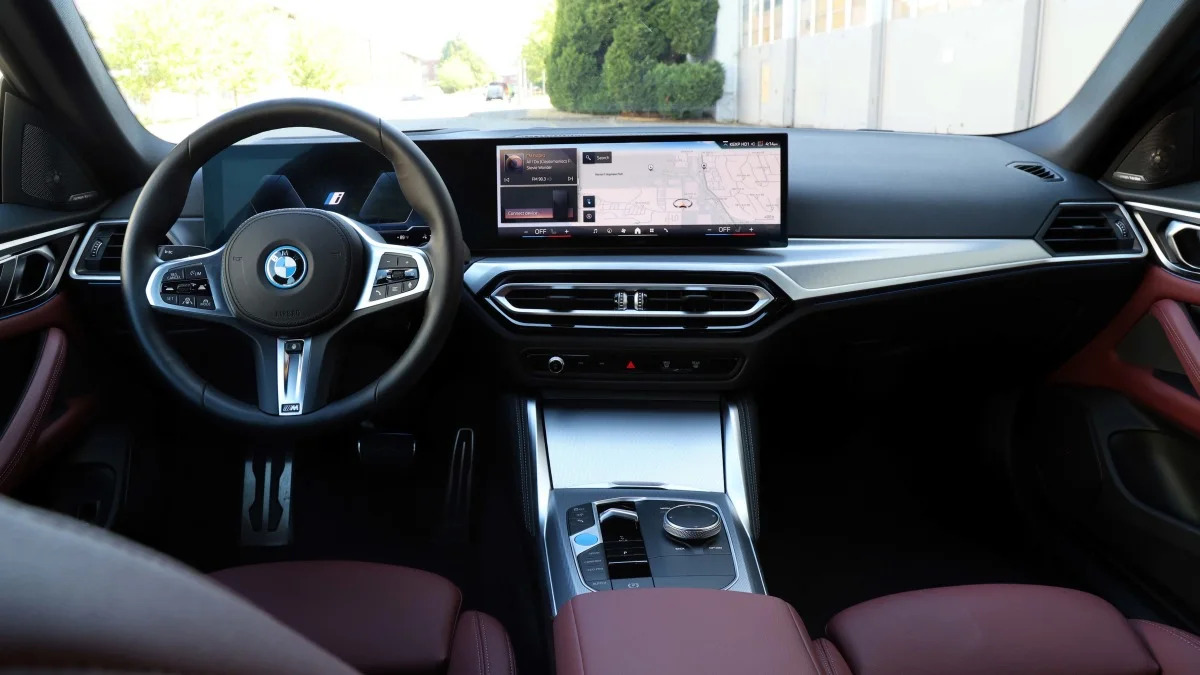
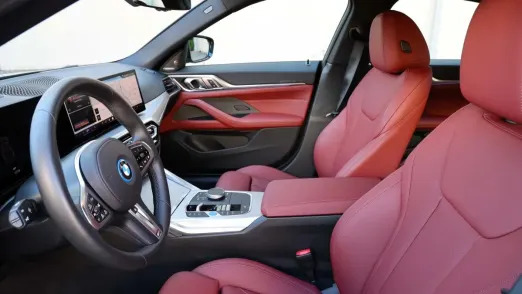
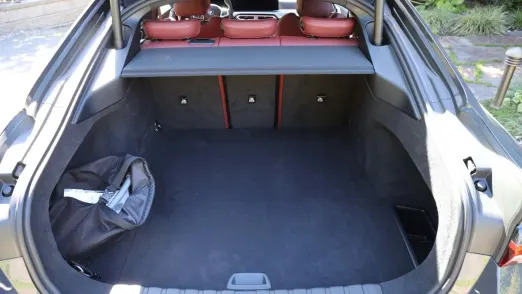
Other stuff that was easy to like
BMW seat thigh extenders, always appreciated.
The $875 Harman Kardon stereo upgrade was solid.
The 4 Series liftback bodystyle offers a lot of utility, not the least of which: The car was visiting during a week of 90-degree-plus heat. The key fob lacks a favorite feature of mine, the ability to roll down the windows remotely to ventilate the car when it has been locked up and broiling inside. I didn’t have access to the My BMW app, but an owner could use it to precondition the interior temperature (at some expense to battery state, considering the oven-like interior heat it’s having to overcome). Lacking either of those features, I got in the habit of using the fob to open the liftback on approach – it worked even better than rolling down the windows, providing a massive and immediate heat dump.
Metallic interior trim in these temperatures got too hot to touch, as did the curved display. But unlike your cellphone when it gets too hot, the car’s screen kept working fine.
I had a chat with it
BMW’s infotainment is complex enough that, rather than learn the system in a limited time, I relied heavily on the voice assistant. It understood every query. It even provided answers when I asked it a couple of times how many miles per kilowatt-hour we were achieving – 3.2 and 3.3 m/kWh were the replies — a stat that wasn’t apparent in the displays. The system then turned the tables and asked me if I would like to learn some driving techniques to improve on that performance. Hey, I’m asking the questions here.
HUD hieroglyphics
The head-up display uses some odd symbols that were trying to communicate something. Was never sure what. Comfort mode has a basic, three-sides-of-a-rectangle-shown-in-perspective thing. Sport mode has a symbol that looks like you’re trailing behind a Federation starship going down the road. As you go faster, the sides pinch in, maybe to let you know you’re at warp? And Eco-Pro mode has a diamond, which also shifts in appearance depending on what you’re doing with the accelerator vs. regen. And at random times some lines come in from the sides for no discernible reason. It was reminiscent of the old Atari “Battlezone” game, except you didn’t get to blow up a tank or earn points.
After a week, the symbols remained as uninformative and ignorable as when the car first arrived. Word is, somewhere in the menus you can turn the symbols off.
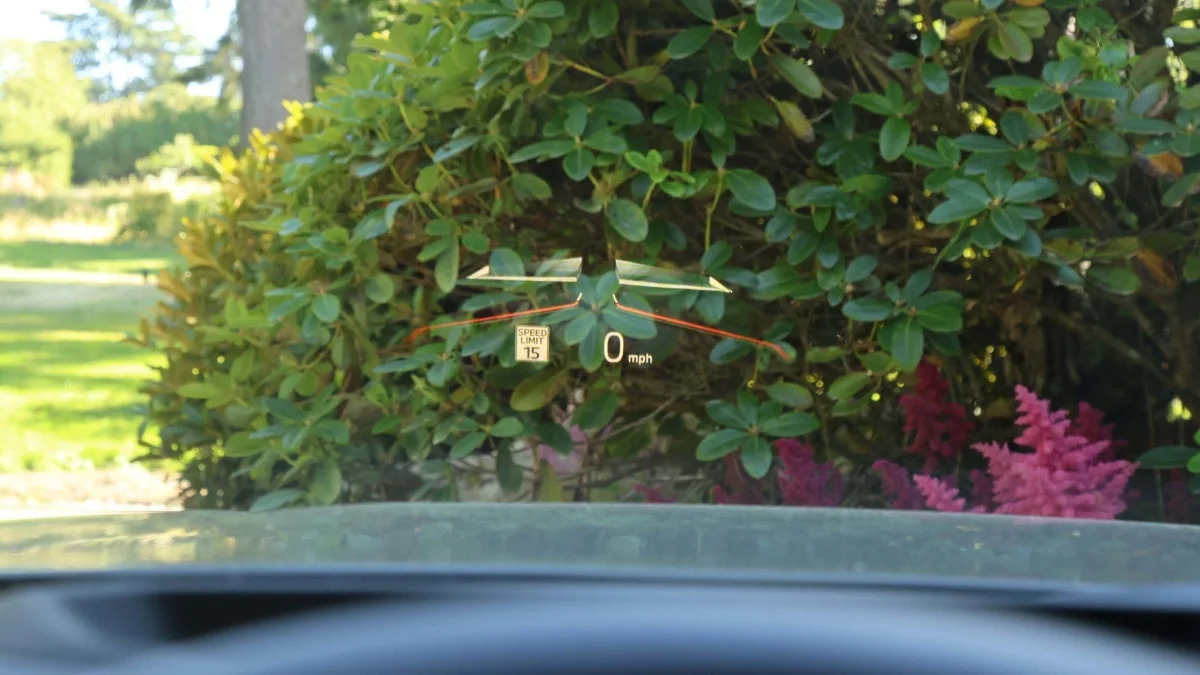
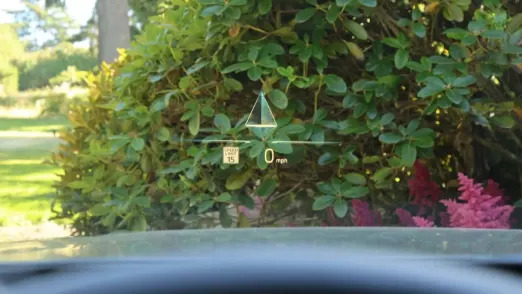
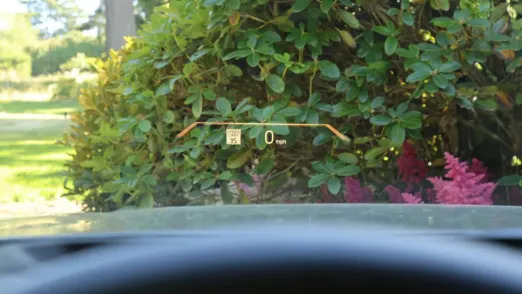
The back seat is for little kids
Nobody ever accused a BMW 3 or 4 Series of being roomy, and that’s the case here. It’s tight in back for big people, and in particular there is no space for your feet under the front seats. Surely BMW knows that people have feet. Maybe you’re supposed to take your shoes off.
Thoughts on charging at home
The i4 can do DC fast charging at a rate up to 195 kW, going from 10% to 80% state of charge in a half-hour. At home on a Level 2 box, the car can go from 0 to 100% in less than 12 hours — or put another way, at a rate of about 30 miles of range per hour. Its cord has adapters for 120 and 240 volts.
I plugged it in to 120 a few times, but didn’t really need to. In a week of driving I didn’t exhaust its 276-mile range rating. And you probably won’t either.



